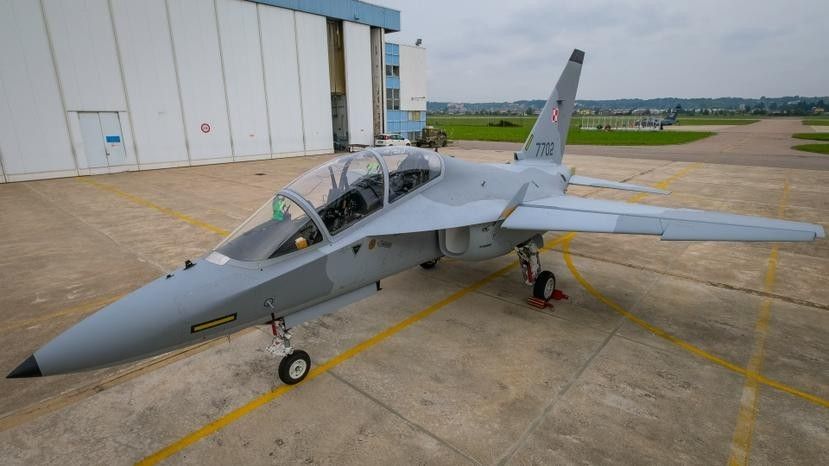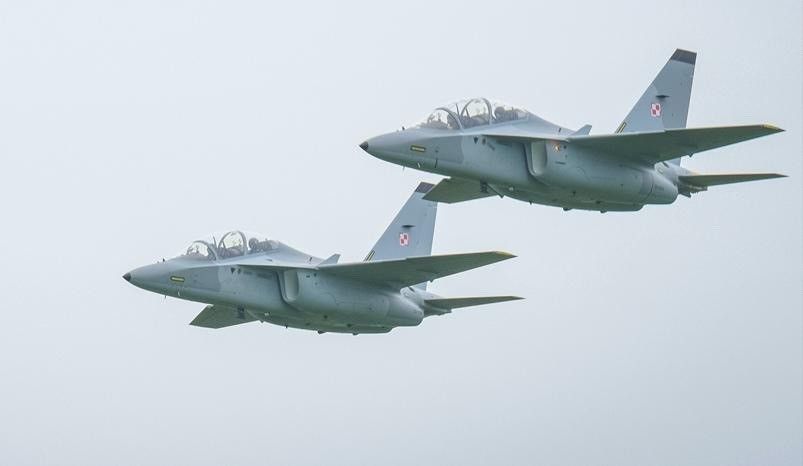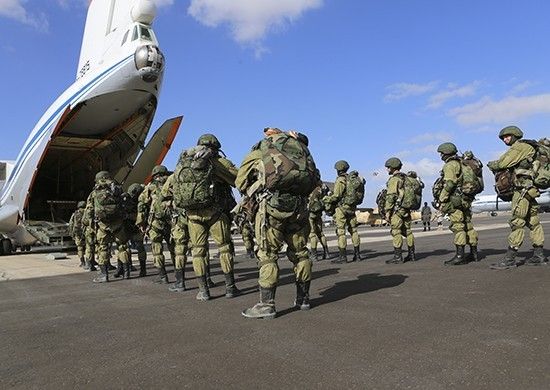Armed Forces
Ukrainian Military Helicopters - Modernization And Development Plans
Ukrainian aviation and defence industries are struggling, in order to realize a modernization programme related to the helicopters used by the Armed Forces. The assets that are at disposal of the Ukrainian government are not sufficient to acquire new rotary-winged aircraft. Instead of, as Poland did, starting a revolution, realized through complete exchange of the used helicopters, a slow evolution of the post-Soviet helicopters takes place, as they are being gradually tailored to meet the current needs of the Ukrainian Armed Forces.
Contrary to the most common opinions, modernization of the Mi-2, Mi-8 and Mi-24 helicopters, carried out without the Russian support, did not start as a result of the Crimean crisis and the conflict which is taking place in the eastern part of the country. Numerous national facilities had been working on development, modernization and potential enhancement of the operational use of those popular helicopters, excluding the use of the Russian components and spare parts, long before the Crimean crisis. The above struggle is a result of the ongoing political and economic needs, as the country was becoming more and more independent. Secondly, the industry was willing to verify the potential export options. Urgent needs of the Ukrainian Army, when it comes to acquisition of the new armament, in the light of the conflict taking place in the eastern part of the territory of the Ukraine, accelerated the progress in numerous, independent programmes. Achieving independence from the Russian-made components, and wider application of the Western technologies that are readily available, or application of technologies acquired via some separate agreements, is a common ground here.
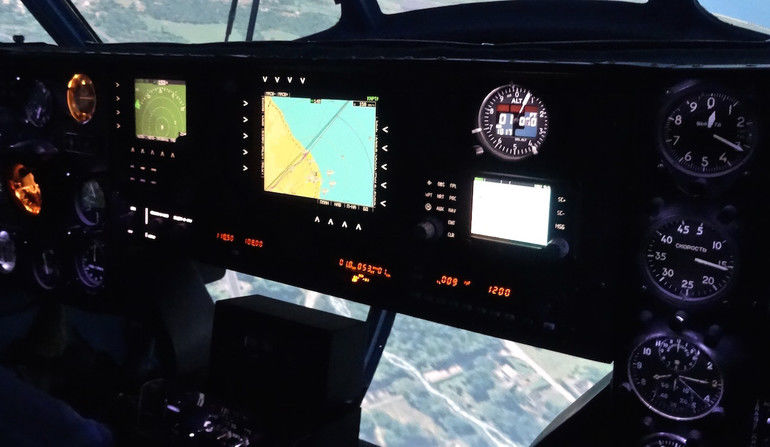
Zaporozhye-based Motor Sich facility has been the most active company within that scope so far. Since many, many years this company has been acting as the main supplier of the helicopter engines for the Russian helicopters. Here, we refer mostly to the Mi-8/Mi-17 and Mi-24 helicopters, as well as the naval Ka-27/32, or attack Ka-52 and Mi-28 rotary-winged aircraft. Motor Sich, since some time now, has been working on expanding the offer with services of fitting the Mi-2, Mi-8 and Mi-24 helicopters with new engines. When it comes to these types, modernization programmes are also being proposed. Finally, the company also works on its own, indigenous designs, that may be treated as a competitive offer, within the international market.
The company cooperates both with the domestic manufacturers, however, Motor Sich is also looking for options of operating and cooperating within foreign markets in the European Union, including Poland. Currently, the Zaporozhye-based facility is focused on modernizing the Mi-8 and Mi-2 helicopters, however plans have been made to carry out a modernization programme for the PZL W-3 rotorcraft. In the future, the company is also willing to develop and introduce its own designs onto the market. MSB-6 Ataman multi-role helicopter is going to be one of the first of the original designs developed by Motor-Sich. Currently, conceptual and research works, regarding this project, are being carried out.
When it comes to the military helicopters, Motor Sich company is – for obvious reasons – the main supplier of the engines and spare parts for the rotary-winged aircraft operated by the Ukrainian Armed Forces. The Zaporozhye based company also offers its latest designs, such as the Mi-8MSB helicopter, for the Army and for the National Guard. An armed variant of this helicopter – Mi-8MSB-W – has been developed quite rapidly. The initial examples of the modernized Mi-8 rotary-winged aircraft have been already delivered to the end users, and the Ukrainian Army, as well as the National Guard, have both expressed their will to acquire several examples, and they have consequently placed their orders. In 2014, the first four examples of the Mi-8MSB-W helicopters were received by the Army. Procurement of the remaining six helicopters is going to be finalized until the end of this year. The National Guard already operates three examples of the above-mentioned helicopter.
Mi-8MSB-W Combat/Transport Helicopter
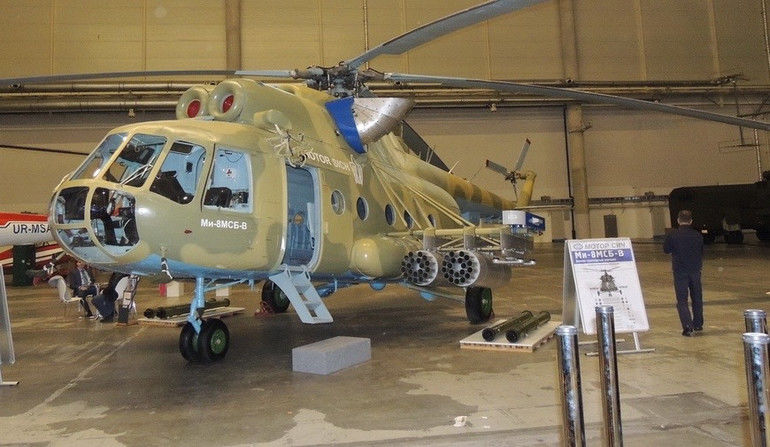
Mi-8MSB-W is equipped with the new TW-3-117WMA SBM1W series 4E engines, with longer inter-overhaul period, if compared with the older version of this powerplant, used in case of the Mi-8T helicopter. With the same power output of 1500 HP, and unchanged main gearbox, the helicopters fitted with the Motor Sich engine have a better performance, in comparison with the non-modernized variant. Average fuel consumption has been decreased, making it possible to add ca. 80 kilometers to the maximum range. Operational altitude has also been increased, from 4.5 up to 8 km and above. Due to the fact that the main gearbox remains unchanged, both power, as well as the maximum take-off weight, are still limited. The cockpit of the helicopter in question is tailored for operation with the use of the night-vision goggles, while the avionics suite may be expanded with a modern GPS system and a coupled multi-function display, placed in between the individual dashboards used by the pilots.
The main feature that differentiates the Mi-8MSB-W helicopter from its civil variety, is the fact that the military variety may carry armament on its external hardpoints. Not only does the armament include the unguided 80 mm rockets, bombs and GUV-1 and GUV-2 gun pods, as the helicopter is also capable of using the Barier-V anti tang guided missiles, Igla air-to-air missiles and VSM-1 mine-deployment systems.
Light Mi-2MSB-W helicopter
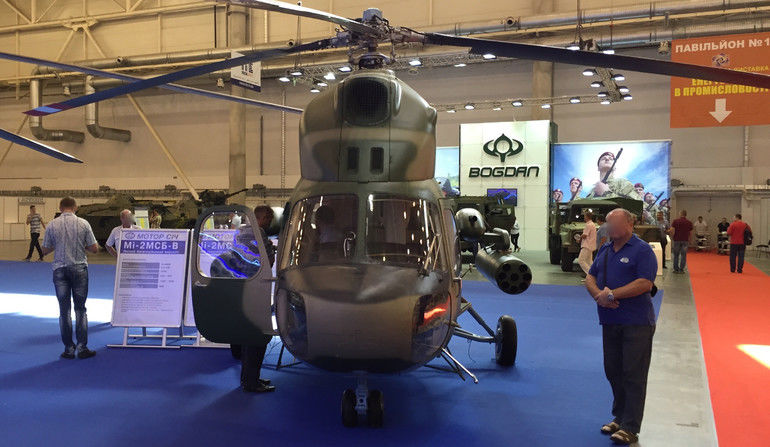
A similar armament inventory, however, in a smaller quantity, may be used by the second helicopter modernized at the Motor Sich company, the armed variant of which has been premièred for the first time in Kiev, in September 2015. Here, we are referring to the light Mi-2MSB helicopter – a variant of the light twin-engined helicopter Mi-2 (NATO code: Hoplite), in which the classic GTD-350 powerplant was replaced with the AI-450M engines manufactured by the Motor Sich company. Each of the engines has a power output 65HP higher than in case of their predecessors. AI-450M engines, with 465 HP power output each, offer 27% lower fuel consumption. They are also 25 kg lighter than their older counterparts. The helicopter – in this configuration – is going to be certified in Ukraine by the end of this year, which means that the Army will be allowed to place an offer regarding the Mi-2MSB rotary-winged aircraft.
The Mi-2MSB-W combat variant is also an interesting proposal. Ukrainian National Guard is already interested in this helicopter. Unfortunately, this version avionics has not been modernized - it has not been fitted with an optronic sensor or targeting system for the precision-guided armament. The new front part of the fuselage – made out of composites – conformal fuel tanks and modern, digitized avionics suite made by a western manufacturer (most probably the Garmin company) is going to be fitted in the version which seems to be much more ambitious – the MSB-2 variant. This helicopter is going to constitute another step towards modernization of these light helicopters. The initial works related to this rotary-winged aircraft have already been started. The combat variant of the MSB-2 helicopter is going to be armed with 4 or more guided anti-tank missiles, such as the Barier-V weapon.

In case of the Mi-2MSB variant, the armament is modest. It includes two machine gun/automatic grenade launcher pods, along with 80 mm unguided rocket pods. Due to the fact that the standard pods, with a capacity of 20 rockets, are too heavy for the Mi-2 helicopter, the Motor Sich company has developed an 8-rocket B8W8MSB pod. The helicopter is capable of carrying two such pods. Within the scope of countermeasures, the Mi-2MSB-W helicopter has been equipped with a flares dispenser, coupled with the Adros IR jamming device, manufactured by the Ukrainian Progress company. The same system is also used on the Mi-8 and Mi-24 helicopters.
It is hard to consider the Mi-2MSB to be an attack helicopter, however, it is perfectly suitable to act as a utility, support, patrol or even a close-air-support helicopter, in case of operations of low intensity. Considering the low costs of operation, Mi-2MSB-W is well-suited to be used by the Ukrainian National Guard.
READ MORE: Mi-2MSB - Ukrainian Combat Variant Of The Mi-2 Helicopter
Mi-24PU-1 Attack Helicopter
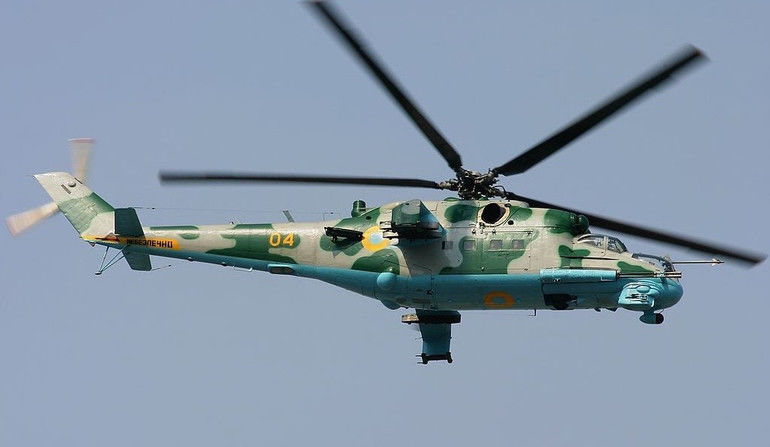
The most ambitious modernization initiative, when it comes to the helicopters used by the Ukrainian Armed Forces, is related to the Mi-24P rotorcraft, which is the backbone of the Ukrainian fleet of the attack helicopters. Mi-24P is a derivative of the Mi-24 helicopter, in which the 12.7 mm machine gun is replaced with a fixed NPU-30 30 mm cannon, mounted on the side.
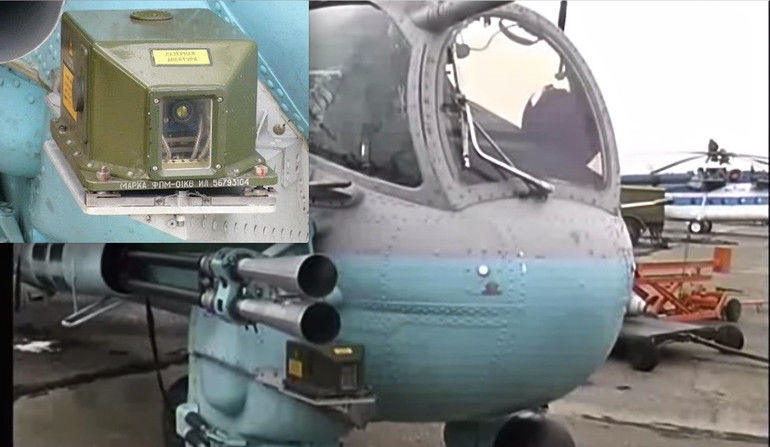
The programme, initiated back in 2008, has been realized by a variety of national and private Ukrainian companies, in cooperation with some western partners, e.g. the Sagem company. Konotop-based Aviation Repair “Aviakon” works facility, specialized in overhauls and modernization of the helicopters, and in provision of support for the foreign operators, is the leader of the aforesaid initiative. This company has been involved – among other projects – in maintenance and overhauls for the Mi-24G (also known as Super-Hind Mk. 4) helicopters, developed in collaboration with the South African ATE company. These helicopters have been introduced into use by the Armed Forces of Azerbaijan.
Similarly as the Mi-24G helicopter, the Ukrainian Mi-24PU-1 is equipped with the modern Motor Sich TV3-117VMA-SBM1V-02 engines, with power output of 2500 HP. Not only do these engines increase the maximum take-off weight of the helicopter (almost 1000 kilograms of increase), they also make it possible to operate at altitudes exceeding 7 thousand meters. Application of these engines also increases the top speed of the helicopter, up to 312 kilometers per hour. It is worth to mention the fact, for the sake of comparison, that the operational ceiling of the AH-64 Apache helicopter is 6400 meters, while its top speed is 293 kilometers per hour.
Mi-24PU-1 variant shares a lot of features with the Mi-24G export version, however, most of the applied solutions have been developed locally. The most important changes – in comparison with the old model – are visible in the avionics suite, which has been modified to be better tailored for use on the contemporary battlefield. The modifications include additional Garmin GPSMAP-695 navigation system radar transponder with a radar altimeter, modern radio and modern flight parameters processing and recording systems. The targeting system has also been significantly upgraded, since not only does it consist of the APS-17 WPM-W sight, as it also includes the Ukrainian Handron Adros FPM-1KB laser range-finder and target designator.
The Handron company also equipped the Mi-24PU-1 helicopter with a self-defence suite, consisting of a flares dispenser and Andros KT-01 AWE jamming system. What is interesting, the crews are using the Polish Night-Vision Goggles, manufactured by the PCO S.A company.
In cooperation with the French Sagem company, plans were made to modernize the avionics suite, including installation of a stabilized Euroflir 410 optronic sensor, complemented with the Sigma 95L satellite navigation system coupled with the Mercator mapping suite and a French onboard computer. The helicopter in such configuration would be probably referred to as the Mi-24PU-2, however, so far, no information is available, suggesting that this variant is going to be created. Most probably, modernization, which has so in-depth character, turned out to be too expensive for the Ukrainians, and the programme has been suspended.
Mi-24PU-1 test programme and armament tests, carried out in 2012, within the area of the Crimean Peninsula.
Despite the above, modernization and upgrade of the helicopters up to the Mi-24PU-1 standard, significantly increased the operational capabilities of the Ukrainian attack helicopters. The said gunships may use their armament (including 80 mm unguided rockets, 250 kg free-falling bombs and cannon pods, as well as the fixed 30 mm cannon) with increased level of precision. The armament has been enriched with the modern Ukrainian laser guided Barier-V ATGM, with a range of 7.5 kilometres. The helicopter may also use the Stugna-P missiles, with a range of 6.5 kilometres.
Unfortunately, even though Mi-24PU-1 helicopter has been officially introduced into service in the Ukrainian Armed Forces, so far only three examples are involved in the programme, including the “prototype example”, with bort number 4 “yellow”. Modernization has been finalized in June 2014, however all of the helicopters are stationed in Konotop. So far, the helicopters are not used operationally.
As it is shown by the above (incomplete) summary of the Ukrainian modernization programmes related to the helicopters, the industry is in possession of a wide scope of capabilities. Costs are most probably the main reason for which the Mi-24PU-1 helicopters have not been used by the frontline units, and for which the remaining programmes are very limited in scale. This only contributes to the problems related to the crew-training process.
Operational use of the equipment is also important, since, so far, the helicopters have not been used effectively. The tactics which could be effective are yet to be defined. In the light of the above, tanks, infantry fighting vehicles and other armoured vehicles, are treated as a priority, when it comes to the procurement programmes realized by the Ukrainians. Aviation, including the helicopters, come after the artillery and the land forces. This situation will probably remain unchanged, until proper operational guidelines are developed, particularly when it comes to protecting the aircraft from the Russian air defence systems, present in the Donbass area.

